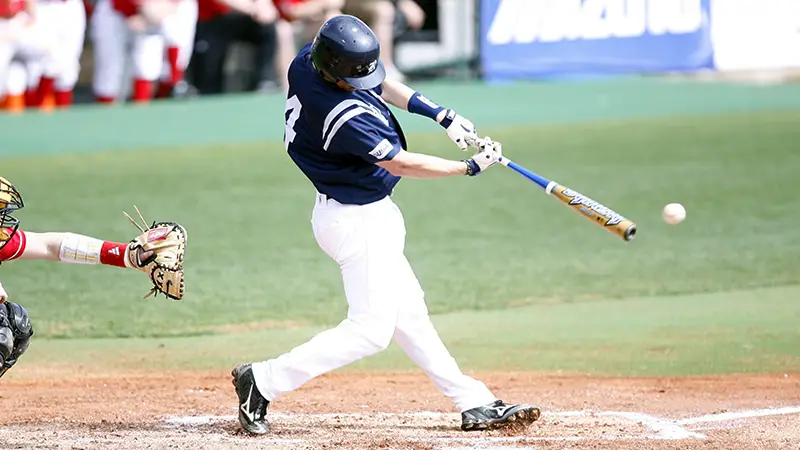Mastering the inside-out swing can transform your baseball game, making you a more versatile hitter. This technique involves swinging the bat from the inside portion of the plate outwards, leading with your hands and allowing the bat barrel to trail.
The result? Consistent hits to the opposite field, a crucial skill for outsmarting pitchers and exploiting defensive gaps.
Imagine standing in the batter’s box, visualizing the pitcher throwing an inside pitch. By focusing on keeping your hands inside and driving the ball to the opposite field, you can refine your swing to be short and compact.
Combining these visualization exercises with actual batting practice will help you master this technique and elevate your overall performance.
Overview of Inside Out Swing Baseball
Inside Out Swing Baseball refers to a specific hitting technique in baseball where the batter aims to hit the ball to the opposite field (for right-handed hitters, this would be hitting to right field, and for left-handed hitters, to left field).
This approach involves swinging the bat in a manner that allows the hitter to make contact with the ball slightly later than usual, often after it has traveled deeper into the strike zone.
Definition and Importance
An inside-out swing in baseball is a hitting technique where you start by driving the bat from the inside part of the plate outwards.
Your hands lead while the bat barrel trails, creating a slicing effect that directs the ball to the opposite field. This method’s importance lies in its ability to turn inside pitches into hits, increasing your versatility as a hitter.
By perfecting this technique, you’ll find opportunities to exploit gaps in the field, making it harder for defenders to position themselves effectively against you.
Effectiveness in Hitting Performance
The inside-out swing significantly enhances hitting performance. By focusing on hitting the ball to the opposite field, this technique allows you more field to work with.
Infielders and pitchers may back up when you’re at the plate, giving you extra options to place the ball. Line drives, the ideal result of an inside-out swing, increase your chances of getting on base.
Even when you miss-hit, the ball might still clear the fence for a home run. Employing this approach means you’ll consistently see the ball hit to center, right-center, or right field, depending on pitch placement.
Key Techniques in Inside Out Swing
The inside out swing in baseball is a nuanced technique that involves specific mechanics and approach to effectively hit the ball to the opposite field.
Here are the key techniques involved in executing an inside out swing:
Hand Placement and Grip
Proper hand placement and grip are crucial for an effective inside-out swing. Grip the bat with your top hand on the bat’s fingers and your bottom hand wrapped securely around it.
Keep your hands close to your body with the top hand slightly leading. This setup provides better control and power during the swing.
Focus on maintaining a firm but flexible grip to adjust quickly to different pitch locations. Additionally, ensure your stance is balanced with a slight bend in your knees.
Rotate your hips and shoulders as you make contact with the ball, driving it to the opposite field. Remember, practice and repetition will help you develop muscle memory, improving your inside-out swing over time.
Footwork and Stance Adjustments
Footwork and stance play pivotal roles in executing an inside-out swing. Position your feet shoulder-width apart and maintain a slight bend in the knees. Align your body so that your chest faces the pitcher directly.
Initiate the swing with a small step towards the pitcher, ensuring your weight transfers smoothly from the back foot to the front foot. This movement helps generate power and keeps your balance intact.
Timing and Execution
Timing and precise execution are essential for mastering the inside-out swing. Start your swing by keeping your top hand close to your body while extending the bottom hand outward.
This motion creates a slicing effect, guiding the ball toward the opposite field. Focus on hitting the ball with a level swing to make solid contact.
Practice this rhythm regularly to improve muscle memory and increase your chances of success in actual games.
Drills to Optimize Inside Out Swing
To optimize your inside out swing in baseball, here are some effective drills that can help you develop the necessary mechanics and timing:
Tee Drills to Improve Swing Path
Using tee drills, you can significantly enhance your inside-out swing. Tee drills help focus on the correct hand placement and bat path, ensuring consistent contact with the ball.
Behind the Hip Tee Drill
Place the tee behind your back hip and hit the ball to the opposite field. This emphasizes keeping your hands inside the ball, crucial for an inside-out swing.
Outside Tee Drill
Position the tee slightly outside the strike zone towards the opposite field. This setup develops the proper bat path for hitting the ball to the opposite field.
High and Outside Tee Drill
Set the tee high and outside the strike zone. This drill helps you practice hitting the ball to the opposite field and develops hand-eye coordination.
Soft Toss Drills and Their Benefits
Soft toss drills let you work on your swing mechanics in a controlled environment. These drills improve timing and hand placement, essential for a successful inside-out swing.
One-Handed Soft Toss
Hold the bat with one hand (dominant hand) and focus on hitting the ball to the opposite field with a slicing effect.
Opposite Field Focus
Have a partner toss the ball softly from the side and aim to hit the ball to the opposite field. This drill helps reinforce the proper swing path and follow-through.
Barrier Soft Toss
Place a barrier, such as a net or cone, on the pull side of the plate. Focus on swinging through the ball towards the opposite field, ensuring the ball stays away from the barrier.
Advanced Techniques: Live Pitching Drills
Practicing with live pitching drills elevates your inside-out swing by simulating real-game conditions. These drills develop timing, reaction speed, and adaptability.
Opposite Field Live Pitching
In a batting cage, face live pitches aimed at different parts of the strike zone, focusing on hitting them to the opposite field. This helps adjust to various pitch locations.
Rearward Acceleration Drill
Start the swing with a small, controlled backward movement of the bat, then drive through the zone quickly. This technique, seen in professional players, builds bat speed and efficiency.
Inside Pitch Challenge
Focus on inside pitches and practice redirecting them to the opposite field. This drill enhances your ability to handle challenging pitches effectively.
Common Mistakes and Corrections
When learning and practicing the inside out swing in baseball, several common mistakes can hinder effectiveness.
Here are these mistakes along with corrections to help refine your technique:
Correcting Swing Path Issues
Many players struggle with an improper swing path when executing an inside-out swing. A common mistake involves extending the arms too early, leading to a loss of power and control.
To correct this, focus on keeping your hands inside the ball longer. This helps maintain the bat angle and ensures you generate optimal power.
Another frequent issue is rolling over the hands too soon. This can be mitigated by practicing drills that emphasize late barrel turn.
For instance, tee drills where you intentionally aim to hit the inside of the ball can reinforce the correct swing path.
Addressing Timing Challenges
Timing poses a significant challenge in perfecting the inside-out swing. Players often swing prematurely, resulting in weak contact or foul balls.
To improve timing, work on recognizing the pitch earlier. Soft toss drills, where the ball is tossed from the side, can train your eyes to better track the ball’s release and movement.
Batting against live pitching also helps hone your timing. Begin with slower pitches and gradually increase speed.
This incremental approach allows your muscle memory to adjust, making your swing more adaptable to varying pitch speeds.
Avoiding Common Misconceptions
Avoiding common misconceptions about the inside out swing in baseball is crucial for developing a clear understanding and effective execution.
Here are some misconceptions to be aware of:
Inside Out Swing is Only for Opposite Field Hitters
While the inside out swing is often associated with hitting the ball to the opposite field (right field for right-handed hitters, left field for left-handed hitters), it’s not exclusively for this purpose.
The technique involves staying inside the ball longer and can be used to adjust to pitches on the outer half of the plate, regardless of where you aim to hit the ball.
Inside Out Swing Means Weak Contact
Some believe that an inside out swing results in weaker contact or sacrifices power. However, a properly executed inside out swing can generate solid contact and even power, especially when driving the ball to the gaps in the opposite field. It’s about leveraging mechanics to maximize bat control and contact consistency.
Inside Out Swing Is Only for Off-Speed Pitches
While the inside out swing is effective against off-speed pitches and breaking balls away from the hitter’s dominant side, it can also be used against fastballs. The key is timing and recognizing pitch location to adjust your swing accordingly.
Inside Out Swing Requires Changing Your Swing Completely
Implementing an inside out swing does involve adjustments, but it doesn’t necessarily mean a complete overhaul of your natural swing mechanics.
It’s about fine-tuning your approach to handle pitches on the outer half of the plate more effectively while maintaining your overall hitting style.
Inside Out Swing Is Only for Advanced Hitters
Developing proficiency in the inside out swing can benefit hitters of all levels, from youth to professional baseball players.
It’s a technique that can be learned and practiced over time to improve plate coverage and consistency in hitting to all fields.
Frequently Asked Questions
What is an inside-out swing in baseball?
An inside-out swing in baseball involves keeping your hands inside the ball and swinging in a way that directs the ball toward the opposite field.
Why is hand placement important in an inside-out swing?
Proper hand placement is crucial as it helps maintain control and balance during the swing. By keeping your hands inside the ball longer, you can better direct the ball to the opposite field, making it harder for defenders to anticipate your hits.
How can footwork affect my inside-out swing?
Footwork is essential because it helps in maintaining balance and generating power. Proper foot positioning allows you to pivot correctly and transfer weight efficiently, which is vital for a controlled and powerful inside-out swing.
What common mistakes should I avoid when executing an inside-out swing?
Common mistakes include casting (extending your arms too early), not staying balanced, and poor hand placement. These errors can lead to weak contact and inconsistent hitting.
What drills can help improve my inside-out swing?
Drills like soft toss and live pitching practice can help improve your inside-out swing. Focus on drills that encourage keeping your hands inside the ball longer and recognizing pitch timing.
Conclusion
Mastering the inside-out swing can significantly elevate your hitting game. By focusing on hand placement, footwork, and timing, you’ll develop a level swing and better muscle memory.
Correcting common mistakes and implementing targeted drills will help you maintain control and balance. Engaging your lower body mechanics ensures a powerful and consistent swing.
Embrace these techniques and you’ll become a more versatile hitter, enhancing your overall performance on the field.
Additionally, understanding the importance of pitch recognition can further optimize your inside-out swing. Consistently practicing with varied pitch speeds and locations will fine-tune your reaction time and accuracy.








Pat Bloom